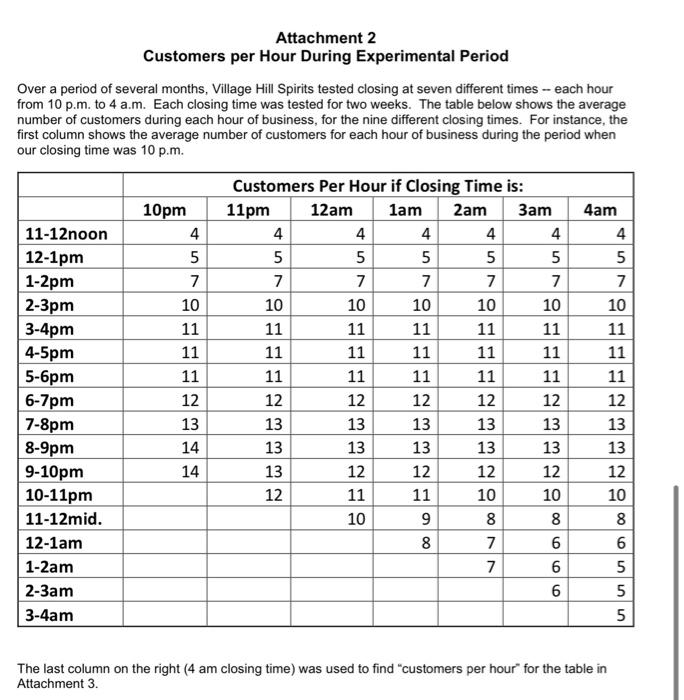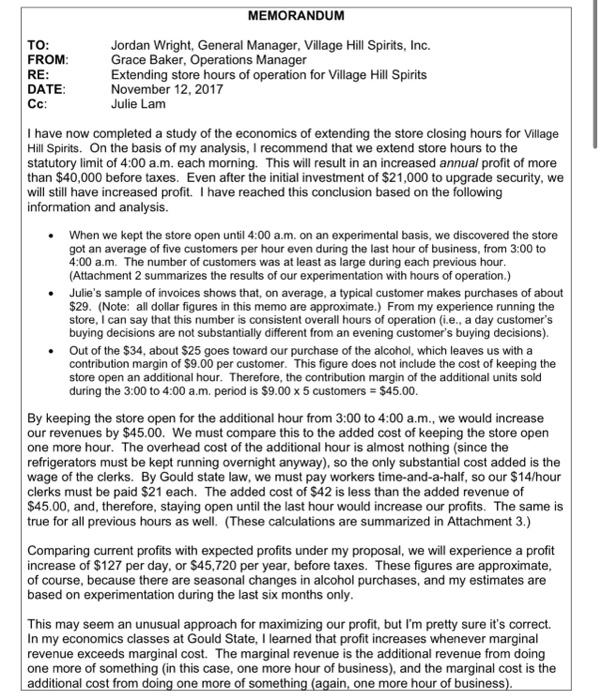If there are any additional issues you think are relevant to the choice of closing time, be sure to mention them. Is there anything missing from the analysis? Are there any
matters that require additional data collection or research?
can you please Answer all the questions thank you
5 Attachment 2 Customers per Hour During Experimental Period Over a period of several months, Village Hill Spirits tested closing at seven different times -- each hour from 10 p.m. to 4 a.m. Each closing time was tested for two weeks. The table below shows the average number of customers during each hour of business, for the nine different closing times. For instance, the first column shows the average number of customers for each hour of business during the period when our closing time was 10 p.m. Customers Per Hour if Closing Time is: 10pm 11pm 12am lam 2am 3am 4am 11-12noon 4 4 4 4 4 4 4 12-1pm 5 5 5 5 5 5 5 1-2pm 7 7 7 7 7 7 7 2-3pm 10 10 10 10 10 10 10 3-4pm 11 11 11 11 11 11 11 4-5pm 11 11 11 11 11 11 11 5-6pm 11 11 11 11 11 11 11 6-7pm 12 12 12 12 12 12 12 7-8pm 13 13 13 13 13 13 13 8-9pm 14 13 13 13 9-10pm 14 13 12 10-11pm 12 11 11 10 10 10 11-12mid. 10 9 8 8 8 12-1am 8 7 6 6 1-2am 7 6 5 2-3am 6 5 3-4am 5 13 13 HH 13 12 ANW 12 12 12 00 ON W 9 000 0 00 unun 5 The last column on the right (4 am closing time) was used to find "customers per hour' for the table in Attachment 3 Cc: MEMORANDUM TO: Jordan Wright, General Manager, Village Hill Spirits, Inc. FROM Grace Baker, Operations Manager RE: Extending store hours of operation for Village Hill Spirits DATE: November 12, 2017 Julie Lam I have now completed a study of the economics of extending the store closing hours for Village Hill Spirits. On the basis of my analysis, I recommend that we extend store hours to the statutory limit of 4:00 a.m. each morning. This will result in an increased annual profit of more than $40,000 before taxes. Even after the initial investment of $21,000 to upgrade security, we will still have increased profit. I have reached this conclusion based on the following information and analysis. When we kept the store open until 4:00 a.m. on an experimental basis, we discovered the store got an average of five customers per hour even during the last hour of business, from 3:00 to 4:00 a.m. The number of customers was at least as large during each previous hour. (Attachment 2 summarizes the results of our experimentation with hours of operation.) Julie's sample of invoices shows that, on average, a typical customer makes purchases of about $29. (Note: all dollar figures in this memo are approximate.) From my experience running the store, I can say that this number is consistent overall hours of operation (ie., a day customer's buying decisions are not substantially different from an evening customer's buying decisions). Out of the $34. about $25 goes toward our purchase of the alcohol, which leaves us with a contribution margin of $9.00 per customer. This figure does not include the cost of keeping the store open an additional hour. Therefore, the contribution margin of the additional units sold during the 3:00 to 4:00 a.m. period is $9.00 x 5 customers = $45.00. By keeping the store open for the additional hour from 3:00 to 4:00 a.m., we would increase our revenues by $45.00. We must compare this to the added cost of keeping the store open one more hour. The overhead cost of the additional hour is almost nothing (since the refrigerators must be kept running overnight anyway), so the only substantial cost added is the wage of the clerks. By Gould state law, we must pay workers time-and-a-half, so our $14/hour clerks must be paid $21 each. The added cost of $42 is less than the added revenue of $45.00, and therefore, staying open until the last hour would increase our profits. The same is true for all previous hours as well. (These calculations are summarized in Attachment 3.) Comparing current profits with expected profits under my proposal, we will experience a profit increase of $127 per day, or $45,720 per year, before taxes. These figures are approximate, of course, because there are seasonal changes in alcohol purchases, and my estimates are based on experimentation during the last six months only. This may seem an unusual approach for maximizing our profit, but I'm pretty sure it's correct. In my economics classes at Gould State, I learned that profit increases whenever marginal revenue exceeds marginal cost. The marginal revenue is the additional revenue from doing one more of something in this case, one more hour of business), and the marginal cost is the additional cost from doing one more of something (again, one more hour of business)








